Pharmacodynamics Important Notes
- Therapeutic index
- It helps in the assessment of the safety of drugs
- The larger the therapeutic index, the safer the drug
- Penicillin has a larger therapeutic index
- Affinity
- It is the ability of the drug to bind to a receptor
- Agonist
- A drug that initiates pharmacological reaction after combining with receptors
- It has
- More affinity
- High intrinsic activity
- Antagonist
- A drug that bonds to receptors but it is not capable to produce any action
- It produces receptor blockade
- It has
- Affinity same as an agonist
- Poor intrinsic activity
- Partial agonist
- A drug with
- Affinity equal to agonist
- Less intrinsic activity
- A drug with
- Additive effect
- Two drugs with the same effect produce an effect that is equal to the sum of the effects of individual drug
- Example: ephedrine+aminophylline in bronchial asthma
- Synergism
- Two drugs with the same effect produce an effect that is greater than the sum of the effects of individual drug
- Example: procaine + adrenaline
- Antagonism
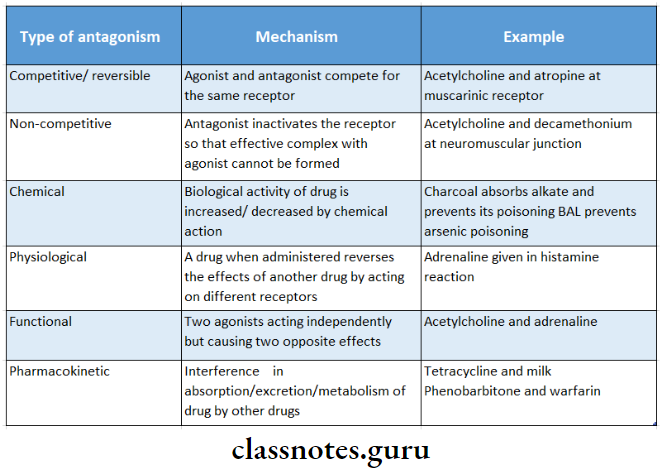
Pharmacodynamics Long Essays
Question 1. Describe the principles & mechanism of action of drugs with examples. Add a note of enzyme induction.
Answer:
Principle:
- Drugs produce their effects by interacting with the physiological systems of the organisms.
- By such interactions, drugs modify the rate of functions of various systems but do not change the basic functions.
Types of Drug Action:
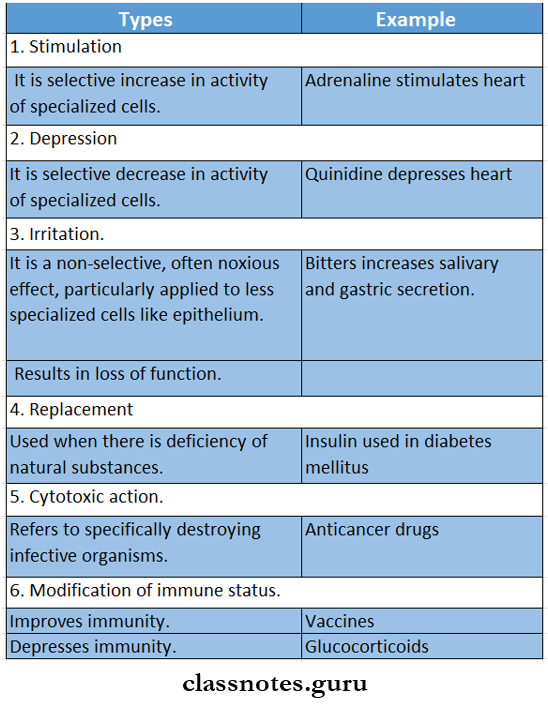
Mechanism of drug action:
- Physical action.
- Glucocorticoids
- The action of drug results from its physical properties.
- Adsorption-activated charcoal in poisoning.
- Mass of the drug – bulk laxatives like psyllium.
- Osmotic property – osmotic diuretics, mannitol.
- Radioactivity – Radioiodine 1131
- Glucocorticoids
- Chemical action.
- Drugs interact according to simple chemical reactions.
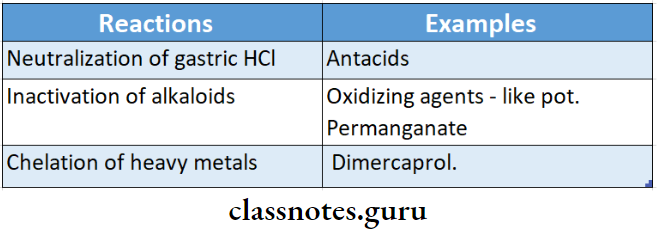
Read And Learn More: Pharmacology Question and Answers
- Through enzymes:
- Drugs can either increase/stimulate or decrease/inhibit enzymatic action.
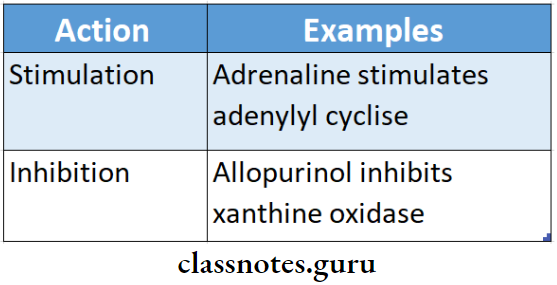
- Through receptors.
- Drugs may act by interacting with receptors in the body.
- Receptors have specificity & selectivity.
- Similarly, drugs are relatively selective.
- Receptors may be present in the cell membrane, in the cytoplasm or in the nucleus.
- Example: Adrenaline binds at adrenergic receptors.
- Through ion channels.
- Drugs may interfere with the movement of ions across specific channels
- Example: calcium channel blockers.
- By altering metabolic processes.
- Drugs may alter the metabolic pathway in the mi- cro-organism resulting in the destruction of the micro-organisms.
- Example: Sulphonamides interfere with bacterial folic acid synthesis.
Enzyme induction:
- The synthesis of microsomal enzymes, mainly cytochrome P450 can be enhanced by certain drugs & environmental pollutants.
- This is called enzyme induction.
- It speeds up the biotransformation of the inducing drug.
- Example: phenobarbital, rifampicin, and alcohol.
- It involves microsomal enzymes in the liver as well as other organs.
- Increase the rate of metabolism by 2-4 fold.
- Induction takes 4-14 days to reach the peak.
Enzyme induction Consequences:
- Decreased intensity of action of drugs that are inactivated by metabolism.
- Increased intensity of action of drugs that are activated by metabolism.
- Development of tolerance to drugs.
- May result in toxicity & therapeutic failure.
- May result in diseases
- Example: Antiepileptics enhance the breakdown of Vit. D – re- sulting in osteomalacia.
- Intermittent use of an inducer may interfere with the adjustment of the dose of another drug.
- Some endogenous substrates are metabolized faster.
Enzyme induction Uses:
- Congenital nonhemolytic jaundice.
- Cushing’s syndrome.
- Chronic poisoning.
- Liver disease.
Question 2. Discuss factors modifying drug action with examples.
Answer:
Factors Modifying Drug Action:
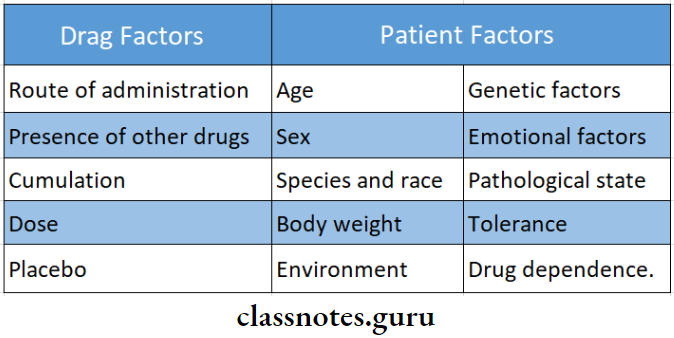
- Drug Factors:
1. Route of administration.
- It may modify the speed & intensity of drug response.
- Example: Magnesium sulfate.
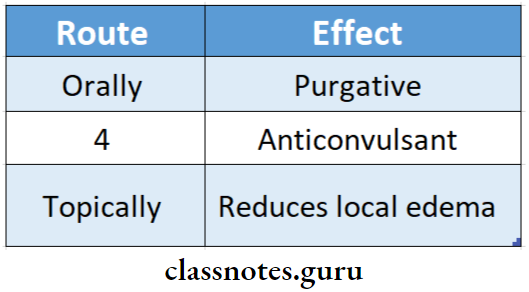
2. Presence of another drug.
- Drugs may interact with each other & modify the response.
- Example: Hydralazine + propranolol used in hypertension.
- Succinylcholine – induces arrhythmias in digitalized patients.
3. Cumulation.
- When the rate of elimination of the drug is slower than the rate of administration, the drug gets cumulated in the body.
- Example: Digoxin cumulates & results in toxicity.
- Chloroquine cumulate & cause retinal damage.
4. Dose.
- The dose of the drug can modify the drug response.
- An increase in dose increases drug response but only till the maximum is reached.
- Further increase in dose may lead to adverse effects.
- Example: Neostigmine.
- Therapeutic doses-enhances muscle power
- Higher doses cause muscle paralysis.
2. Sex.
- Smaller body size & hormonal effects in females may influence drug action.
- Example: Some antihypertensive drugs like clonidine may interfere with sexual functions in males but not in females.
- Some drugs are prohibited in pregnancy and lactation.
3. Species & race.
- Different response to drugs occurs in different species & races.
Drug Action Examples:
- Rabbits are resistant to atropine.
- Blacks require a high dose while mangoes require a low dose of atropine to dilate their pupils.
4. Body weight.
- It influences the concentration of the drug attained at the site of action.
- Accordingly, the dose is calculated as follows.
. Drug Action Environment.
- Exposure to insecticides, carcinogens, and tobacco smoke induces drug metabolism.
- Food interferes with the absorption of drugs.
- Example: Tetracycline forms complexes with calcium. Present in food & are poorly absorbed.
6. Drug Action Genetic factors.
- Drug response is mediated genetically.
- It occurs due to variations in the amount of drug-metabolizing enzymes.
- Example: Acetylation of drugs like INH, and hydralazine.
- Their acetylation differs in fast and slow acetylators.
- Slow acetylators may develop lupus erythematosus with hydralazine.
7. Emotional/psychological states.
- Doctor-patient relationship influences the drug response.
- Example: Use of placebo.
8. Pathological state.
- The presence of certain diseases influences drug response.

9. Tolerance.
- It refers to the requirement of a higher dose of a drug to produce a given response.
- It may be natural or acquired.
- Example: Tolerance develops to the sedative action of chlorpromazine.
10. Drug dependence.
- It is a drug response that always includes a compulsion to take a drug on a continuous or periodic basis in order to experience its psychic effects & sometimes to avoid the discomfort of its absence.
- Example: Alcohol, barbiturates.
Pharmacodynamics Short Essays
Question 1. Pharmacodynamics.
Answer:
Pharmacodynamics Definition:
Pharmacodynamics is the study of the actions of drugs on the body and their mechanisms of action.
Question 2. Placebo.
Answer:
Placebo is the inert dosage form with no specific biological activity.
- It is a dummy preparation
- It is a Latin word that means “I will please”.
- It may induce physiological responses.
- Example: Placebo can release endorphins in the brain causing analgesia.
- It supplements pharmacological effects.
- Placebo effects are variable.
- Example: Placebo may induce sleep on the first night but not subsequently.
Placebo Uses:
- In clinical trials to minimize bias.
- To relieve subjective symptoms.
Factors Influencing it:
- Patient factor.
- Patients with neurotic symptoms respond well.
- Drug factor.
- The response can be affected by the drug presentation or route of administration.
- Example: the color of the drug, injections.
- Doctor factors.
- The doctor’s personality and doctor-patient relationship may affect the response.
- Example: Lactose, sucrose, injections of distilled water.
Question 3. Drug antagonism.
Answer:
Drug antagonism Definition:
One drug decreasing or inhibiting the action of another drug is called antagonism.
Drug antagonism Types:
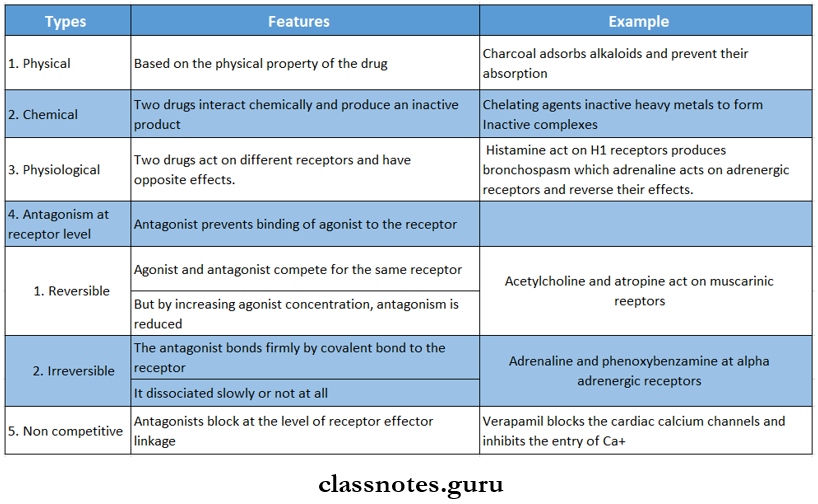
Question 4. Drug Synergism.
Answer:
- When the action of one drug is increased or facilitated by another drug the combination is synergistic
Drug Synergism Types:
- Additive
- Effect of two drugs are in same direction Side effects of each may be different
- But the combination is better-tolerated Effect of A + B = effect of A+ effect of B
- Example: aspirin + Paracetamol- used as analgesic
- Supra additive
- The effect of the combination is greater than the individual effects
- Effect of A+ B> effect of A+ effect of B
- One component given alone is inactive
- Example: acetylcholine + physostigmine
Pharmacodynamics Short Answers
Question 1. Drug synergism.
Answer:
When the action of one drug is increased or facilitated by another drug, the combination is synergistic.
Drug synergism Types:
- Additive.
- The effect of the two drugs is in the same direction.
- Effect of A + B = effect of A+ effect of B.
- Example: Aspirin + paracetamol – used as analgesic.
- Supra-additive (potentiation)
- The effect of the combination is greater than the individual effects.
- Effects of A+B > effect of A+ effect of B.
- Example: Acetylcholine + physostigmine.
Question 2. Drug antagonism.
Answer:
Drug antagonism Types:
- Physical antagonism.
- Chemical antagonism.
- Physiological antagonism.
- Antagonism at the receptor level.
- Reversible.
- Irreversible.
- Non-competitive antagonism.
Question 3. Tachyphylaxis.
Answer:
Tachyphylaxis is the rapid development of tolerance.
- When a drug is given repeatedly at short intervals, tolerance develops & is known as tachyphylaxis.
- These drugs act by displacing noradrenaline from sympathetic nerve endings.
- There may be slow dissociation of the drug from the receptor, thereby blocking the receptor.
- Other mechanisms involve the internalization of receptors, homeostatic adaptation, etc.
- Example: Epinephrine given repeatedly in bronchial asthma may not give desired response.
Question 4. Bioassay.
Answer:
Bioassay is the determination of the amount of biological activity in a unit’s quality of preparation.
Bioassay Indications:
- When the chemical composition of a substance is not known.
- When the chemical assay method is too complex.
- When drugs differ in composition but have the same action.
- When the active principle is unknown.
Bioassay Methods:
- Direct comparison on the same tissues.
- Direct assay on several animals.
- Indirect assays.
Viva Voice:
- The larger the therapeutic index the safer the drug
- Drug efficacy refers to the maximal response that can be elicited by the drug
- Drug potency refers to the amount of drug needed to produce a certain response
